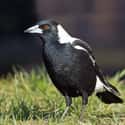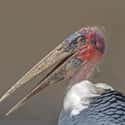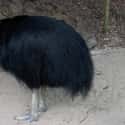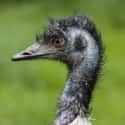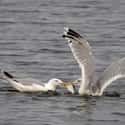-
(#6) Australian Magpie
- Cracticus tibicen
Size: The Australian Magpie ranges between 14.5 and 17 inches in total length.
Location: They are found all over Australia and parts of New Guinea.
Distinguishing Features: The Australian Magpie is predominantly black with white highlights along its wingtips and the back of its neck.
Why You Should Be Scared: Normally, these little birds will not get too close to humans and generally are accepting of having them nearby... unless it's mating season. Some of the birds, nearly all of which are male, will swoop down and attack unsuspecting people walking near their nests. They are known to attack pedestrians who wander within 50 feet of their nests, which are not easy to see from ground level. This gives the Australian Magpie a nasty reputation as being a bird who enjoys swooping down and attacking people for no clear reason.
-
(#7) Lammergeier
- Gypaetus barbatus
Size: They can reach a length of up to 49 inches with a rather impressive wingspan of up to 9.3 feet.
Location: South Central Asia, parts of Southern Europe, the Middle East and Western Africa
Distinguishing Features: The Lammergeier is commonly known as the Bearded Vulture due to the fluffed out plumage along the base of its neck, which looks somewhat like a beard.
Why You Should Be Scared: As a species of vulture, they typically only feed on carrion with a preference for subsisting almost entirely on bone. They don't often attack other animals, but have been known to snatch small mammals, which they kill with their strong talons and beak. They don't represent a threat to adults, but there have been anecdotal reports of Lammergeiers snatching small children.
-
(#3) Marabou Stork
- Leptoptilos crumeniferus
Size: They have the largest wingspan of any living bird with a length of approximately 12-13.3 feet. The birds typically weigh in at around 20 lbs., making them relatively large birds.
Location: Sub-Saharan Africa in both wet and arid habitats.
Distinguishing Features: It has red and black splotches on its sparsely-feathered head. Its body consists of bluish-grey feathers with a white underbelly. They also have a large, distinctive air pouch that hangs below the throat.
Why You Should Be Scared: These birds are large and look unpleasant. It doesn't help that they practice something called urohydrosis, which means they poop all over their legs to regulate their body temperature. They are strong and could cause a great deal of damage to a person should they decide to attack with their long, powerful beak, but the biggest threat to people revolves around their horrid stench.
-
(#1) Cassowary
- Casuarius
Size: Southern Cassowary's can grow to a large height of nearly 6 feet, weighing in at upwards of 154 lbs.
Location: Indonesia, New Guinea, and Northeastern Australia
Distinguishing Features: Their bodies are almost entirely black with a bright blue neck and head. They have incredibly strong talons on their three-toed feet with strong legs.
Why You Should Be Scared: While these birds are rather large, your biggest fear from them isn't being snapped at with their sharp beak; it's being slashed apart by their lethal dagger-like claws on their inner toes—which can reach a length of 4.7 inches. Cassowaries have been known to kill a human when threatened.
-
(#4) Emu
- Dromaius novaehollandiae
Size: the Emu is the largest native bird to Australia reaching a height of up to 6.3 feet.
Location: Most regions of Eastern, Central, and Western Australia
Distinguishing Features: Their size and inability to achieve flight sometimes leads people to confuse them with their African counterpart, the Ostrich. Similar to the Ostrich, they can achieve a sprint of up to 31 mph making them incredibly fast and powerful birds.
Why You Should Be Scared: Emus are incredibly powerful strong birds and just like Ostriches, they possess strong legs tipped with long talons. They are typically wary of humans due to them correctly identifying us as predators, but when threatened, they can become aggressive and lash out with their powerful claws.
-
(#9) Herring Gull
- Larus argentatus
Size: These gulls can get relatively large and grow up to 26 inches in length.
Location: Primarily throughout northern Europe and as far north as the coast of Ireland.
Distinguishing Features: Most are white with grey wings while some have darker feathers at their wingtips.
Why You Should Be Scared: You're probably thinking that you have seen these birds all over the place thousands of times and they aren't a threat to anyone. While an individual bird is little more than a nuisance thanks to its lack of fear in stealing food from an unsuspecting person's hands, they represent a greater danger to aircraft. European Herring Gulls have been known to fly into jet engine intake manifolds, causing damage and even airline accidents.
New Random Displays Display All By Ranking
About This Tool
Birds are one of the most beloved creatures in the animal kingdom, most of them are harmless and very timid, but some birds are extremely cruel. Speaking of the most dangerous birds, most people first think of large raptors such as eagles or vultures. In fact, there are very few incidents of eagles hurting people in real life. On the contrary, there are some seemingly docile and mild bird attacks that humans cannot bear.
Although some birds are slow or even unable to fly, they can cause fatal damage with their sharp and powerful claws. The random tool introduced 10 of the most terrifying types of birds on the planet, some of them are common in daily life.
Our data comes from Ranker, If you want to participate in the ranking of items displayed on this page, please click here.











